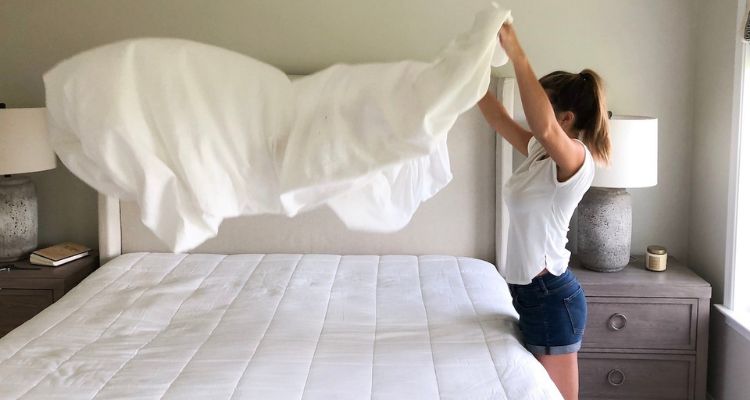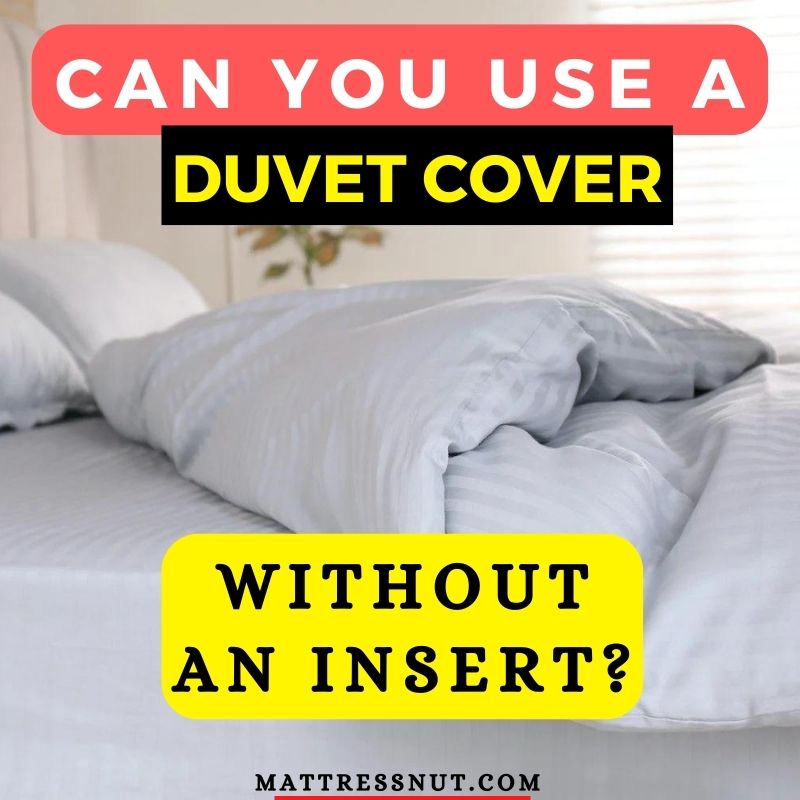A duvet cover is an insulating coat that goes over your duvet, similar to how a pillowcase goes over your pillow. For ease of removal and put on, a duvet has buttons or a zipper at one end. Many duvet covers have ties inside the corners that you can use to keep your duvet insert in place.
You can use a duvet cover without an insert, but it will not be as fluffy or cozy. Moreover, it will not serve its purpose of providing warmth. With varying duvet covers, you will have only a couple of sheets to cover yourself without the insert.
Why Use A Duvet Cover?
A duvet cover is a covering that encases your duvet and keeps it crisp and clean. It is easy to remove and wash. Duvet covers protect your inserts, comforters, or blankets, no matter how regularly you use them. In addition, duvet covers add a decorative touch to your bedroom.

What’s The Difference Between A Duvet Cover And An Insert?
A duvet cover goes over your insert like a protective layer. It is typically a decorative fabric on the outside and a more practical fabric on the inside. The duvet cover helps extend the life of your duvet insert by protecting it from spills and dirt.
The covers keep the insert away from dust and other potential damage. Duvet covers help in changing the image of your bedroom. You can switch out the duvet cover when you want a new style or design.
What Is The Purpose Of A Duvet Insert?
A duvet insert is a quilt or comforter often used in cold weather climates. It is a thick, quilted bedding usually filled with down (check the top rated down duvet inserts), cotton, or other synthetic fibers. The duvet covers are easy to remove, allowing you to wash both elements separately. The purpose of a duvet insert is to provide warmth and insulation in a bed.
How Do I Choose a Duvet Insert
When it comes to choosing a duvet insert, there are a few things you’ll want to keep in mind. First, you’ll need to check what size insert you need. Duvet inserts come in all different sizes, from twin to king. Second, you’ll need to consider what type of fill you want. Duvet inserts can be filled with down, feathers, synthetic fill, or a combination of all three.
Third, you’ll need to analyze what level of warmth you need. Duvet inserts are available in various warmth levels, from light to extra warmth. And finally, you’ll need to decide what fabric you want. Duvet inserts are available in various fabrics, from cotton to linen.
Choosing the perfect duvet insert can be overwhelming with all these factors. But don’t worry, we’re here to help. Just consider these options, and you’ll be sure to find the perfect insert for your needs.
How to Wash a Duvet Cover without an Insert?
Duvet covers are easy to wash as long as they are not heavily decorated. They are just two layers of regular bed sheets stitched together as a case. You can add a comforter or an insert to it. The process of washing a duvet cover without an insert is quite simple:
- Remove the duvet cover, separating it from the insert.
- Wash the duvet cover in your washing machine using cold water and laundry detergent. Be sure to use a gentle cycle to avoid damaging the fabric.
- Once the duvet cover is clean, dry it in the dryer. Make sure to set the dryer’s heat setting to low.
- Re-insert the duvet into the cover and enjoy your clean and fresh duvet!
Should You Be Using A Top Sheet With A Duvet?
Using a top sheet along with a duvet is simply a personal preference. Some people prefer the extra layer of warmth and protection that a top sheet provides, while others find it unnecessary.
If you tend to sleep cold, you may find that using a top sheet helps to keep you warmer. Alternatively, if you tend to sleep hot, you may find that skipping the top sheet helps you to stay cool.

How Much Bigger Should A Duvet Cover Be Than The Insert?
A duvet cover should be about 2-3 inches bigger than the insert on each side. This allows you to easily put the insert into the cover and also prevents the insert from shifting around inside the cover.
If the cover is bigger, inserting it won’t be easy and may shift around inside the cover. If the cover is too small, it will be difficult to align the insert into it, and the insert may fold and create uneven bumps.
Are Duvet Covers Good Blanket Alternatives?
Duvet covers are a great alternative to blankets, especially if you want something lighter and more versatile. Duvet covers are from different materials, including cotton, linen (check 6 amazing linen duvet covers), and even silk, so you can choose the perfect one to suit your needs. They’re usually cheaper than blankets and easy to clean.
What’s a good lightweight insert to use during summer?
For warm summer nights, a good lightweight insert to use inside a duvet cover is a cotton or bamboo quilt. Look for one with a low warmth rating so it doesn’t get too hot. A lightweight down or down alternative comforter around 300-400 thread count would also work well. The lightweight insert will provide some warmth if needed but won’t be too insulated.
Can I use a duvet cover with a bedspread or blanket inside?
Yes, you can use a duvet cover with a bedspread, quilt, or blanket inside rather than a duvet insert. Make sure it is not too bulky or it will be difficult to get inside the duvet cover. Tuck in the edges well so the bedspread stays in place. This can work in a pinch but may not look as full, tidy or tailored as using an actual duvet insert.
How to Choose a Duvet?
When choosing a duvet, you will need to consider a few aspects. The first and foremost is taking into account the climate of your place. You’ll want to choose a light duvet if you live in a warm place (check 8 great lightweight duvet inserts). The light is in the context of fabric, make, and even colors to wick off heat.
At the same time, you’ll want to choose a heavier duvet if you live in a chilly region. Again this can be in terms of heavier fabric material or even darker colors.
You’ll want to remember the size of your bed and the number of people using it. For a single person, a smaller duvet is better than a full-size one. Whereas for couples, the bigger, the better. Similarly, a twin bed will need a different size duvet than a queen bed.
Thirdly, with so many intricate designs and patterns in the market, you’ll want to consider the style of your bedroom. A duvet can add a lot of personality to a room, so you’ll want to choose one that fits your style.
Lastly, you’ll want to consider the price. Duvets’ prices can vary from affordable to very expensive. Considering all of these facts, you should be able to choose the perfect duvet for your home.
How Long Do Duvet Inserts Last?
Duvet inserts typically last for several years, although the exact lifespan will depend on the quality of the insert and how often it is used.
If you take good care of your duvet insert and only use it occasionally, it could last for over 10 years. However, if you use it frequently or do not store it properly, it may only last for a few years.
In Conclusion
Though there is no harm in using a duvet cover without an insert, the purpose of a duvet cover may not be served. A duvet cover keeps an insert clean and provides liveliness to your room.
Using a duvet cover without an insert may work fine during summer as an insert will be too warm for the night. But overall, if you intend to get a duvet, it’s best to have an insert. It will complement the look of your duvet and give it a worthy look.
Use a duvet cover without an insert FAQs
Can you use a duvet cover without a comforter inside?
A duvet cover is a removable, insulating cover for your duvet. A duvet is a comforter, often filled with soft material. Duvet covers keep your duvet clean and various designs and colors and help revamp your bedroom look. You can use a duvet cover without a comforter inside, but it will not be as warm or cozy.
What are the strings in a duvet cover for?
The strings in a duvet cover tie the duvet to the insert. This ensures the insert won't slide off from the ends. The duvet stays smooth because everything is secured in place.
How do you make a duvet cover look full?
To make a duvet look fuller, you can apply certain hacks. First, choose a duvet cover that is a bit bigger than your duvet. Another is to fluff up your duvet before putting the cover on. Lastly, you can fold the upper ends of the duvet in a Z shape to make it appear fluffier.
What goes under a duvet cover?
Duvet cover is a decorative cover for a type of bedding. It is typically made of cloth and has a zipper or closure. A duvet cover can protect a duvet from dirt and spills and add style to a bedroom. Duvet covers are available in various colors, patterns, and fabrics.

